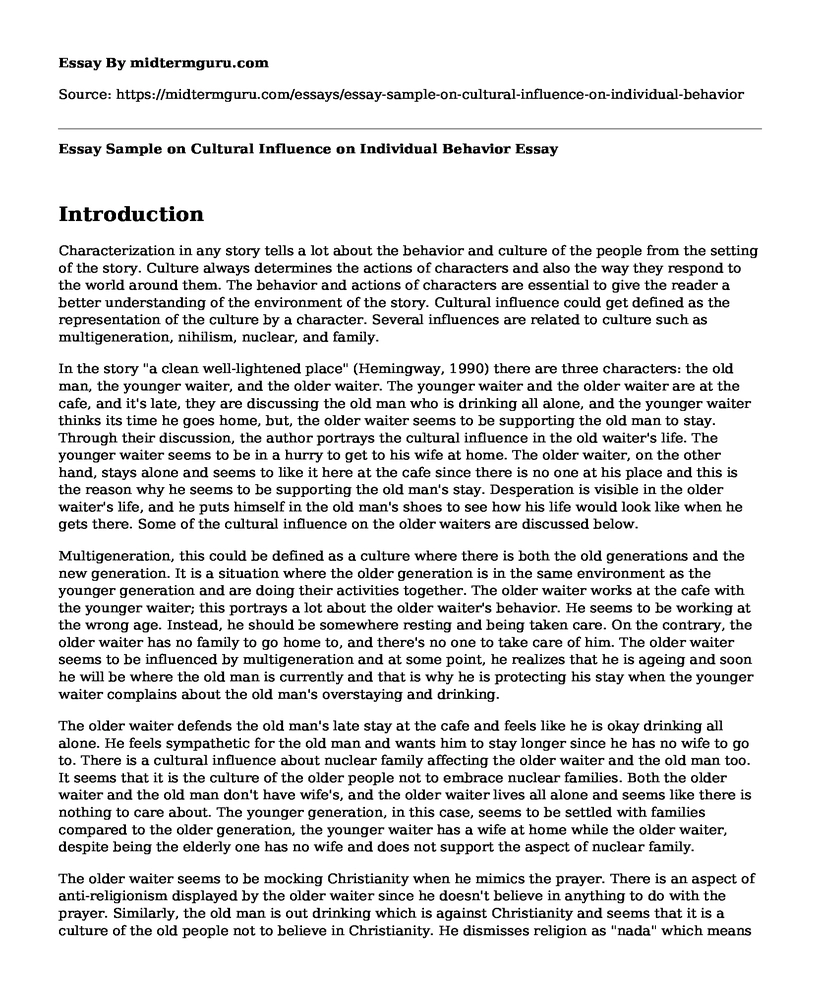Introduction
Characterization in any story tells a lot about the behavior and culture of the people from the setting of the story. Culture always determines the actions of characters and also the way they respond to the world around them. The behavior and actions of characters are essential to give the reader a better understanding of the environment of the story. Cultural influence could get defined as the representation of the culture by a character. Several influences are related to culture such as multigeneration, nihilism, nuclear, and family.
In the story "a clean well-lightened place" (Hemingway, 1990) there are three characters: the old man, the younger waiter, and the older waiter. The younger waiter and the older waiter are at the cafe, and it's late, they are discussing the old man who is drinking all alone, and the younger waiter thinks its time he goes home, but, the older waiter seems to be supporting the old man to stay. Through their discussion, the author portrays the cultural influence in the old waiter's life. The younger waiter seems to be in a hurry to get to his wife at home. The older waiter, on the other hand, stays alone and seems to like it here at the cafe since there is no one at his place and this is the reason why he seems to be supporting the old man's stay. Desperation is visible in the older waiter's life, and he puts himself in the old man's shoes to see how his life would look like when he gets there. Some of the cultural influence on the older waiters are discussed below.
Multigeneration, this could be defined as a culture where there is both the old generations and the new generation. It is a situation where the older generation is in the same environment as the younger generation and are doing their activities together. The older waiter works at the cafe with the younger waiter; this portrays a lot about the older waiter's behavior. He seems to be working at the wrong age. Instead, he should be somewhere resting and being taken care. On the contrary, the older waiter has no family to go home to, and there's no one to take care of him. The older waiter seems to be influenced by multigeneration and at some point, he realizes that he is ageing and soon he will be where the old man is currently and that is why he is protecting his stay when the younger waiter complains about the old man's overstaying and drinking.
The older waiter defends the old man's late stay at the cafe and feels like he is okay drinking all alone. He feels sympathetic for the old man and wants him to stay longer since he has no wife to go to. There is a cultural influence about nuclear family affecting the older waiter and the old man too. It seems that it is the culture of the older people not to embrace nuclear families. Both the older waiter and the old man don't have wife's, and the older waiter lives all alone and seems like there is nothing to care about. The younger generation, in this case, seems to be settled with families compared to the older generation, the younger waiter has a wife at home while the older waiter, despite being the elderly one has no wife and does not support the aspect of nuclear family.
The older waiter seems to be mocking Christianity when he mimics the prayer. There is an aspect of anti-religionism displayed by the older waiter since he doesn't believe in anything to do with the prayer. Similarly, the old man is out drinking which is against Christianity and seems that it is a culture of the old people not to believe in Christianity. He dismisses religion as "nada" which means nothing. The older waiter only finds peace in well-lit cafes (Hemingway 379).
The older waiter displays nihilism when tends not to believe in anything. The "nothingness" (Hemingway, 1990) shows that he doubts a lot of things including religion. Perforation of the religious text "nada" (Hemingway, 1990) means so much and is a clear indication that the older waiter has been affected by the existing culture of being anti-religious. Nihilism seems common among modernist texts of their period. In his statement, "hail nothing full of nothing, nothing is with thee" (Hemingway, 1990) expresses the emptiness within him and the loneliness. All this emptiness and the "nothing" is what plagues both the older waiter and the old man.
Conclusion
In conclusion, the older waiter's character gets mostly based on his culture and the environment he has lived in. He seems not to support the issue of nuclear family and religion, but instead, he supports staying out at night in the well-lit cafes to have a drink all alone. He sees the old man as a person to admire and does not support the younger waiter's life of going to his wife every night. It is clear that the past generation has affected the older waiter looking into his way of life and his interests.
Works Cited
Hemingway, Ernest. A clean well-lighted place. Creative Education, 1990.
Hemingway, Ernest. "A clean, well-lighted place." The short stories of Ernest Hemingway (1933): 379-83.
Cite this page
Essay Sample on Cultural Influence on Individual Behavior. (2022, Oct 05). Retrieved from https://midtermguru.com/essays/essay-sample-on-cultural-influence-on-individual-behavior
If you are the original author of this essay and no longer wish to have it published on the midtermguru.com website, please click below to request its removal:
- Questions on Psychology: Sleep and Stress
- Essay on Thoughts and Feelings About the Poem: A Little Learning
- Essay on Challenges of Older Adults Experience in Managing Their Health
- Paper Example on Occupational Therapy: Culturally Diverse Families
- Essay Sample on Birth Order
- Paper Example on Cultural Studies, Multiculturalism, and Media Culture
- Paxil: Antidepressant Prescription to Treat Anxiety Disorders and Stress - Essay Sample







